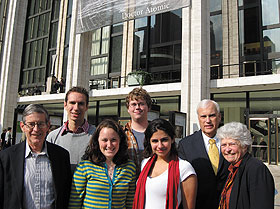  |
| HOME | THIS ISSUE | CALENDAR | GRANTS | BACK ISSUES | < BACK | NEXT > |
Students enjoy science-based opera at the Met by Carol Davidge - October 20, 2008 |
||||
| The time: July 1945. The place: The Los Alamos National Laboratory in New Mexico. The action: Scientists prepare to test the first nuclear weapon. And it’s an opera. Dr. Atomic, by the contemporary post-minimalist American composer John Adams and librettist Peter Sellars, had its debut at New York’s Metropolitan Opera recently. Thanks to a special partnership between the School of Fine Arts and the Met, science and arts students from the UConn were able to attend the final dress rehearsal on Oct. 9. The trip was one of the activities in the Year of Science. The UConn science students reacted enthusiastically, saying they wanted to participate because it afforded them a different experience from their daily studies. Most had never been to an opera. “It breathed new life into opera – it was something more modern,” said David Lindsay, a biomedical engineering student. “The story was intense, the orchestra played beautifully, the singing was excellent, the sets were spectacular, and I really liked the weather simulations, where the rain storms seemed so realistic.” Singers portrayed physicist Robert Oppenheimer, who worked on the Manhattan Project, his wife Kitty Oppenheimer, Kitty’s maid Pasqualita, physicist Edward Teller, Army General Leslie Grove, and others. In the opera, various characters protest or defend the test. Some wonder whether a chain reaction will cause the atmosphere to ignite and destroy the entire earth. Others protest the killing of civilians in Japan. Yet others describe toxic radioactive fallout that could harm humans in Los Alamos. As the bomb is being armed, thunder blasts, lightning flashes, and rain and wind blow wildly. Despite protests, General Grove orders that the test will go on. When the skies clear and the wind ceases, the scientists in Dr. Atomic put on black sunglasses and drop silently to their knees until the bright light of the bomb blast flashes across the stage, ending the opera. Physics student Sarah Lamb said she was fascinated by how much modern technology was used to accomplish the visual and sound effects. “It was totally different from what you think of as opera,” she said. Mitchell Underwood, also a physics major, had learned about the Manhattan Project in middle school and was curious how music could be incorporated into such a technical, scientific story.
“It was an accurate portrayal of one of the most important events in our history,” he said, “and the music and special effects were incredible.” Anastasia Gussen, a microbiology student, said she was impressed by the way something designed for destruction was used as the basis for an opera. During the rehearsal, David Woods, dean of the School of Fine Arts, sat near the physics students. “When the equations came on the screen, they reacted to the scientific part of the opera, while the music students reacted to the music,” he noted. Woods initiated the joint program in 2002 with then-Metropolitan Opera director Joe Volpe. “We’re the only university in the U.S. with this collaborative, and we work with the Met on a variety of opportunities for students,” he said. During an intermission, Dr. Atomic composer John Adams explained that he chooses “themes and symbols that constitute our American consciousness, and in some cases, our American unconsciousness.” He said he chose to create a stage work about the atomic bomb test since it epitomizes how the “whole relationship between humans and the world changed after we had the power to destroy everything.” Because Robert Oppenheimer was not only an accomplished scientist, but read poetry and spoke five languages, Adams included poems from the Sanskrit text the Bhagavad-Gita, Tewa American Pueblo Indian culture, 17th century English preacher John Donne, and 20th-century American feminist activist Muriel Rukeyser. Among the physics faculty attending the rehearsal was Winthrop Smith, professor of physics, who specializes in atomic, molecular, and optical physics. Smith said it was an inspiring idea to bring science and arts students together for a day at the opera. |
| ADVANCE HOME |

